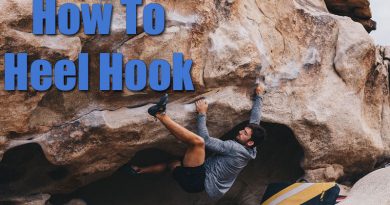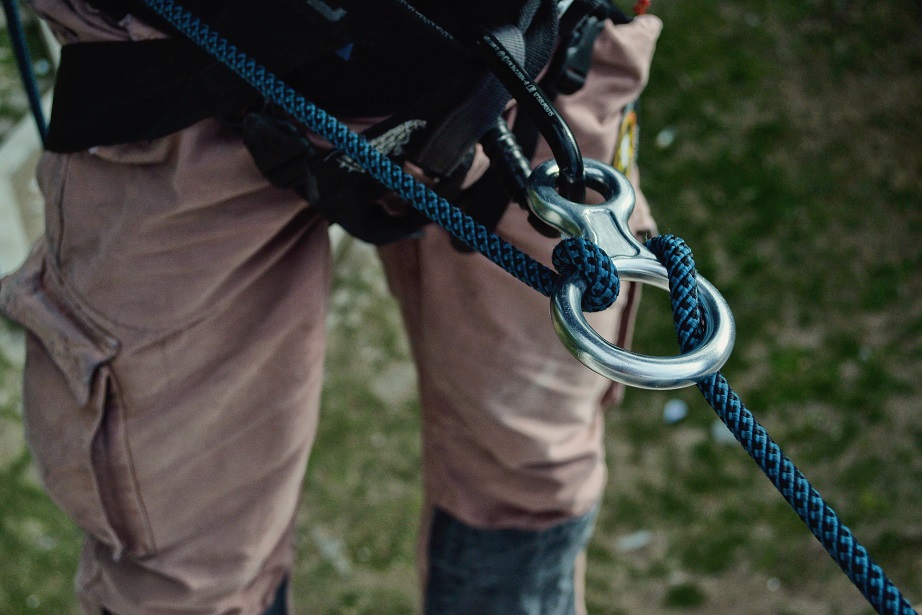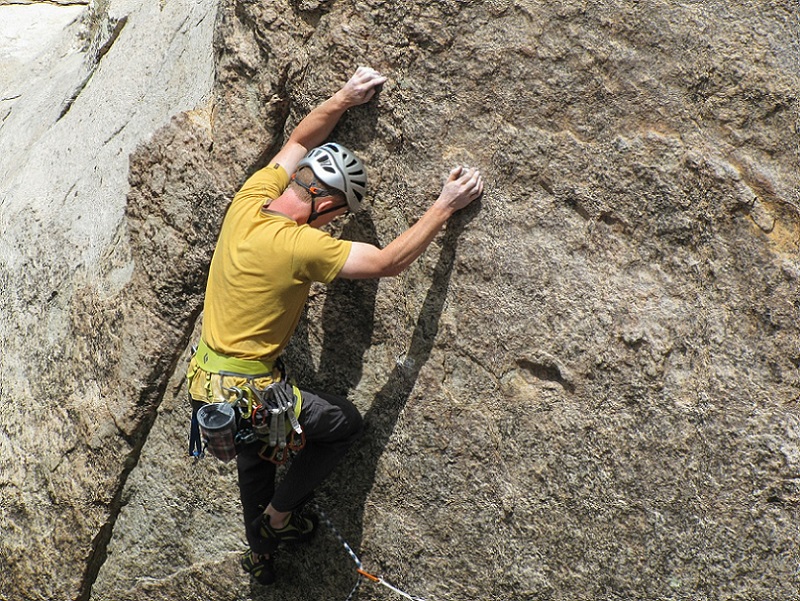¨Flagging¨ in climbing is a technique used to help you climb more statically. It is the motion where you extend one of your legs far away to either the left or the right side of your body. Most commonly, a flagging climber will put one leg on the opposite side of the remaining leg, passing behind it. This is called rear flagging. When the flag is formed on the same side as the flagging leg, it’s called side flagging. The goal in both cases is to shift the climbers center of gravity, so as to prevent swinging away from the wall with one side of the body when reaching for the next hold, an undesirable event to which climbers refer as a ¨barn door¨.
For what type of climber is flagging useful?
While the easy (and true!) answer to this question is: to every climber, flagging is especially useful:
- If you need to climb problems dynamically while other climbers can do it statically
- If you’re exhausted or pumped quickly
- If you have trouble climbing overhangs
- If your body often moves away from the hold you’re reaching out to
Uses of flagging
Flagging serves four main purposes in climbing, which are to:
- Shift your center of gravity
- Prevent a barn door swing
- Increase statical reach
- Climb more energy efficient
The general rule of flagging
To help you visualise what flagging really is, picture a line going through the center of your body, from top to toe. You will want equal distribution of weight on both sides of that line. If you fail to do this, a barn door will inevitably happen.
The barn door is when a hand and foot on the same side of your body are latched on to the wall, while your other hand and foot are cut loose from the wall. Because you’re weight now only rests on one side of the centerline of your body, this position is unstable and the other side will swing away from the wall. This way, the hand and foot that are still on the wall, will both function as a hinge of a door, hence the name ¨barn door¨.
And that’s where flagging comes in. By extending either leg to the other side of your other leg, the centerline moves in that direction. That way, if you’re reaching for the next hold, your body won’t pull away from the wall, helping you to statically reach the next hold.
The Rear Flag and the Side Flag
The rear flag is when the flagging leg crosses the stepping leg behind the knee. This leg that’s passing behind can be placed high up the wall, almost at a 90 degree angle. This is where the name flagging comes from: your body is the pole and the leg perpendicular to your body is the flag.
After it crosses behind the knee, the toes are usually placed firmly against the wall, pressing and smearing, for extra stability. This way the climber opens up space to let go of the hand on the side of the passing leg to reach for the next hold.
In side flagging, the climber simply extends his leg further outwards from its own side: so a left leg would move further out to the left, while the right leg remains on the foothold.
Side flagging is especially useful when you’ve found a hold for an opposing foot and hand, for example a left hand and a right foot. By pressing your flagging foot firmly against the wall, you free up the hand on the opposing side of the body to make a move for the next hold – statically!
Flagging versus Backstepping
Flagging and backstepping are two terms that are commonly confused.
They’re actually quite similar techniques, and usually when you can solve the problem with flagging, you can also solve it with backstepping – and vice versa.
There are some differences between the two though, and they’re worth noting:
In flagging, the body center is a little further away from the wall than in backstepping. This inevitably means that flagging is a little less energy efficient than backstepping.
Generally, flagging is quicker than backstepping, though, as it requires less moves to reposition your feet. So if you can choose to solve a problem with either backstepping or with flagging, you have the option to do it either the quickest (flagging) or the most efficient (backstepping) way.
A last reason why you might want to flag as opposed to backstep, is that backstepping can be difficult when the foothold is really small. In order to backstep, you’ll need to match feet and that becomes difficult on small holds without smearing. This is another reason why you may opt for flagging instead of backstepping.
When the positioning of the footholds allows for it, it is possible to speed up the slowness of backstepping by crosstepping. This basically means swinging your leg between your body and the wall all the way up to the other side of your body and placing it on a hold there. That way, you don’t have to match feet and the slowness of backstepping compared to flagging is somewhat compensated.
Flagging and backstepping are very similar and which one you will choose in a situation is dependent on prefered style, body length and how quick versus energy efficient you want to climb.
Which side should I flag to?
Regardless of if you’re using a rear flag or a side flag, you always want to flag out to the opposite side of the hold that you’re reaching out for.
Flagging is counterbalancing. Pressing your foot against the wall on the same side of the hold that you want to reach, will result in you pressing yourself away from that very same hold.
In short:
- Flagging left is reaching right
- Flagging right is reaching left
- Reaching left is flagging right
- Reaching right is flagging left
How important is smearing for flagging?
Smearing is crucial to flagging successfully.
The mere fact that you extend your leg to either side doesn’t do all that much for shifting your center of gravity. Only by pressing your foot firmly against the wall, AKA Smearing, will you really start to shift your center of gravity.
So if you’re not engaging your smear properly when you flag, that’s definitely something you could work on to improve your flagging technique.
Using the dropknee in a side flag
Just like smearing, the dropknee is also a great auxiliary technique that will help you flag properly.
When doing a side flag, you need to press down on the foothold on which you stand as much as possible. pressing down at a zero degree angle, really helps with this. And thatś where the dropknee comes in.
by using the dropknee, you will get your hip as close to the wall as possible, and thus position yourself right above the foothold on which you’ll press down. By combining the pressure on the foothold, and the smearing from your flagging leg, you’ll find yourself in an incredibly stable position to reach the next hold statically.
The bottomline
Flagging helps you climb more problems, more easily, by reducing the energy it takes you to reach for the next hold, by preventing a ¨barn door¨ from happening, by climbing more statically and by stabilising your body by shifting your center of gravity.
To flag, you need to extend your leg to the opposite side of the hold you’re reaching for. The leg may either extend to its own side (side flagging) or behind the leg which rests on a foothold (rear flagging).
Several other climbing techniques are helpful in mastering flagging. These include smearing and the dropknee.






